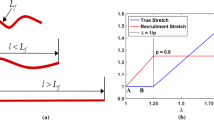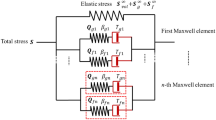Abstract
Nearly all soft tissues, including the vascular tissue, present a certain degree of viscoelastic material response, which becomes apparent performing multiple relaxation tests over a wide range of strain levels and plotting the resulting stress relaxation curves, nonlinear viscoelasticity of the tissue. Changes in relaxation rate at each strain may occur at multiple strain levels. A constitutive formulation considering the particular features of the vascular tissue, such as anisotropy, together with these nonlinear viscoelastic phenomena is here presented and used to fit stress–stretch curves from experimental relaxation tests. This constitutive model was used to fit several data set of in vitro experimental stress relaxation tests performed on ovine and porcine aorta. The good fitting of the experimental data shows the capability of the model to reproduce the viscoelastic response of the vascular tissue.
Similar content being viewed by others
References
Alastrué V. et al.: Numerical framework for patient-specific computational modelling of vascular tissue. Commun. Numer. Meth. Engng. 26, 35–51 (2010)
Alastrué V. et al.: Experimental study and constitutive modelling of the passive mechanical properties of the ovine infrarenal vena cava tissue. J. Biomech. 41, 3038–3045 (2008)
Antonov P. et al.: Age dependent changes of arterial wall viscoelasticity. Clin. Hemorheol. Microcirc. 39, 63–68 (2008)
Armentano R.L. et al.: An in vitro study of cryopreserved and fresh human arteries: A comparison with ePTFE prostheses and human arteries studied non-invasively in vivo. Cryobiology 52, 17–26 (2006)
Armentano R.L. et al.: Effects of hypertension on viscoelasticity of carotid and femoral arteries in humans. Hypertension 26, 48–54 (1995)
Barra J. et al.: Symptoms and outcome measures of pelvic organ prolapse. Clin. Obstet. Gynecol. 738, 1040–1050 (1993)
Bonifasi-Lista C. et al.: Viscoelastic properties of the human medial collateral ligament under longitudinal, transverse and shear loading. J. Orthopaed. Res. 23, 67–76 (2005)
Drapaca C.S. et al.: Nonlinear constitutive laws in viscoelasticity. Math. Mech. Solids 12, 475–501 (2007)
Duernwald S. et al.: Constitutive equations for ligament and other soft tissue: Evaluation by experiment. Acta Mech. 205, 23–33 (2009)
Duernwald S. et al.: Viscoelastic relaxation and recovery of tendon. Ann. Biomed. Eng. 37, 1131–1140 (2009)
Fung Y.C.: Biomechanics. Mechanical Propeties of Living Tissues. Springer, New York (1993)
Gow B.S., Taylor M.G.: Measurement of viscoelastic properties of arteries in the living dog. Circ. Res. 23, 111–122 (1968)
Haslach H.W.: Nonlinear viscoelastic, thermodynamically consistent, models for biological soft tissue. Biomech. Model Mechanobiol. 3, 172–189 (2005)
Hingorani R.V. et al.: Nonlinear viscoelasticity in rabbit medial collateral ligament. Ann. Biomed. Eng. 32, 306–312 (2004)
Holzapfel G.A.: Nonlinear Solid Mechanics. Wiley, New York (2000)
Holzapfel G.A. et al.: Determination of the layer-specific mechanical properties of human coronary arteries with non-atherosclerotic intimal thickening, and related constitutive modelling. Am. J. Physiol. Heart Circ. Physiol. 289, H2048–H2058 (2005)
Holzapfel G.A., Gasser T.C.: A viscoelastic model for fiber-reinforced composites at finite strains: Continuum basis, computational aspects and applications. Comput. Methods Appl. Mech. Eng. 190, 4379–4403 (2001)
Holzapfel G.A. et al.: A structural model for the viscoelastic behaviour of arterial walls: Continuum formultaion and finite element analysis. Eur. J. Mech. A/Solids 21, 441–463 (2002)
Humphrey, J.D.: Continuum biomechanics of soft biological tissues. In: Proceedings of the Royal Society of London. Series A, vol. 175, pp. 1–44 (2002)
Johnson G.A. et al.: A single integral finite strain viscoelastic model of ligaments and tendons. ASME J. Biomech. Eng. 118, 221–226 (1996)
Lu X. et al.: Shear modulus of porcine coronary artery: Contributions of media and adventitia. Am. J. Physiol. Heart Circ. Physiol. 285, H1966–H1975 (2003)
Merodio J., Goicolea J.M.: On thermodynamically consistent constitutive equations for fiber-reinforced nonlinearly viscoelastic solids with apllication to biomechanics. Mech. Res. Commun. 34, 561–571 (2007)
Merodio J., Rajagopal K.R.: On constitutive equations for anisotropic nonlinearly viscoelastic solids. Math. Mech. Solids 12, 131–147 (2007)
Natali A.N. et al.: Viscoelastic response of the periodontal ligament: An experimental-numerical analysis. Connect. Tissue R 45, 222–230 (2004)
Nedjar B.: An anisotropic viscoelastic fibre-matrix model at finite strains: Continuum formulation and computational aspects. Comput. Methods Appl. Mech. Eng. 196, 1745–1756 (2007)
Nguyen T.D. et al.: Modeling the anisotropic finite-deformation viscoelastic behavior of soft fiber-reinforced composites. Int. J. Solids Struct. 44, 8366–8389 (2007)
Peña, E., et al.: A constitutive formulation of vascular tissue mechanics including viscoelasticity and softening behaviour. J. Biomech. (2009, In press)
Peña E. et al.: An anisotropic visco-hyperelastic model for ligaments at finite strains: Formulation and computational aspects. Int. J. Solids Struct. 44, 760–778 (2007)
Peña E. et al.: Computational modelling of diarthrodial joints. Physiological, pathological and pos-surgery simulations. Arch Comput. Method Eng. 14(1), 47–91 (2007)
Peña E. et al.: On modelling nonlinear viscoelastic effects in ligaments. J. Biomech. 41, 2659–2666 (2008)
Pioletti D.P., Rakotomanana L.: Non-linear viscoelastic laws for soft biological tissues. Eur. J. Mech. A/Solids 19, 749–759 (2000)
Provenzano P.P. et al.: Application of nonlinear viscoelastic models to describe ligament behavior. Biomech. Model Mechanobiol. 1, 45–47 (2002)
Schapery R.A.: On the characterization of nonlinear viscoelastic materials. Polym. Eng. Sci. 9, 295–310 (1969)
Silver F.H. et al.: Mechanical behavior of vessel wall: A comparative study of aorta, vena cava, and carotid artery. Ann. Biomed. Eng. 31, 793–803 (2003)
Simo J.C.: On a fully three-dimensional finite-strain viscoelastic damage model: Formulation and computational aspects. Comput. Methods Appl. Mech. Eng. 60, 153–173 (1987)
Simo J.C., Hughes T.J.R.: Computational Inelasticity. Springer, New York (1998)
Simo J.C., Taylor R.L.: Quasi-incompresible finite elasticity in principal stretches. Continuum basis and numerical algorithms. Comput. Methods Appl. Mech. Eng. 85, 273–310 (1991)
Spencer, A.J.M.: Theory of invariants. In: Continuum Physics, pp. 239–253. Academic Press, New York (1954)
Vena P. et al.: A constituent-based model for the nonlinear viscoelastic behavior of ligaments. ASME J. Biomech. Eng. 128, 449–457 (2006)
Author information
Authors and Affiliations
Corresponding author
Rights and permissions
About this article
Cite this article
Peña, J.A., Martínez, M.A. & Peña, E. A formulation to model the nonlinear viscoelastic properties of the vascular tissue. Acta Mech 217, 63–74 (2011). https://doi.org/10.1007/s00707-010-0378-6
Received:
Published:
Issue Date:
DOI: https://doi.org/10.1007/s00707-010-0378-6




